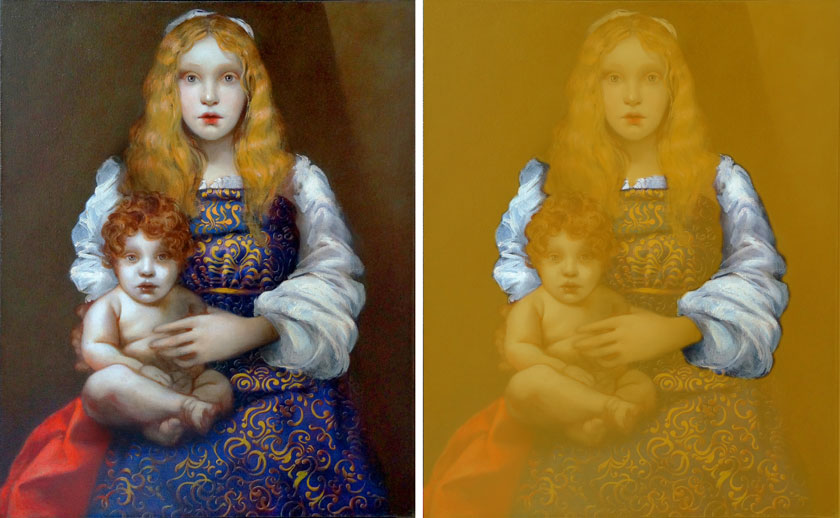Art Lesson 42, Part 9
Discover how to Paint White Clothes Folds
Learn how to paint like the Old Masters!
Old Masters Academy Online Course
Self-study, self-paced online video courseLifetime membershipOne-time payment: $487Enroll Now!Personal Tutoring online + Online Course
Unlimited tutoring by the Academy teachersLifetime membershipOne-time payment: $997Enroll Now!« Back to the Art Lessons List
How to Paint White Clothes Folds
Remember, we started the painting of the white blouse with a White Grisaille over a Brown Brush Sketch. The White Grisaille has dried by now, so we are ready to Glaze it.

Session One
For this task, we prepare Stand Linseed Oil mixed with Yellow Lake and Scarlet Lake. This Glaze is applied with a rigid Hog Brush. We try the Glaze on a single spot – it’s too orange, so more red needs to be added. Now the mix is almost entirely red. The Glaze is spread out over the whole surface, including the lighted and shaded areas. The layer of Glaze should be applied thinly. Later, if we need to make it darker, we will use more layers of Glaze. A thin coat of Glaze allows the White Grisaille to show through.
The shadows can be enhanced by a darker, reddish color. For shadows, we use Burnt Umber and Scarlet Lake. This transparent but dark mix is applied over a wet, red Glaze. It allows for better transition between shaded and lighted passages.
Now we can put the painting aside to dry.
Session Two
Again, we need Scarlet Lake with Stand Linseed Oil as a Medium. This is our Second layer of Glaze over the dry, first one.
Session Three
We continue over the dry Glaze with a mixture of an opaque layer composed of Titanium White and Ultramarine Blue. Stand Linseed Oil is used as a Medium. Here you see how in search of a creative solution, the fabric is repainted with a different color and structure of fabric. We build up a thicker layer of texture; that will be underpainted later. Now we can set the canvas aside to dry or work on other parts of the composition.
Session Four
We prepare a mixture of Titanium White and Charcoal Grey, thinned with Stand Linseed Oil. This is a nice, milky Velatura (which is an opaque Glaze); we apply it over a dry surface, spreading the paint thinly with a soft hair brush. As a result, the darkest areas become whitish, but light areas stay more or less the same. The strong contrast between shade and light is diminished.

Session Five
Now, when the surface is dry, we can continue with pure, unthinned Titanium White. What might look interesting on a sketch, won’t necessarily work well in a painting. It is ok to amend the initial design during the process, like we are doing now. We repaint the contours on the folds of the blouse to make them look more stylish. To find the best design, it is good to create a series of sketches.
We paint over, in a thick impasto manner. As you can see, we work thickly in lighted areas only. The shaded areas are covered thinly.
In the crook of the elbow, fabric has a different nature of folds – they are smaller and more subtle. As we don’t have strict drawing outlines, the design is more flexible and can be repainted, as painters of Venetian School often did.
Session Six
We mix Titanium White, Yellow Ochre and Charcoal Grey. Stand Linseed Oil is used as a Medium. This Glaze is used to mute down the whiteness of the blouse. The Glaze should be applied in a subtle coat.
Session Seven
Even after the painting surface has completely dried, the design of the folds can be amended even further. A new sketch was prepared and now helps us improve the painting. We use unthinned Titanium White and apply it thickly as an Underpainting. You can vary the thickness of the strokes. The thicker the strokes are, the more they stand out and look lighter. And vice versa – shaded passages are painted smoothly and thinly.
There is room for improvisation when searching for a more appealing arrangement of folds. The best way to look for inspiration is to observe real fabric to see how folds form. You may also search and check various reference photos, however, it is not advisable to mindlessly copy what you see in photographs.
We set the canvas aside to dry or work on other parts of the composition.
Session Eight
After the amended Underpainting has completely dried, we proceed with Glazing over it. Do you remember how we Glazed the background? We use the same Glaze mixture for the blouse. For the Glaze, we use Burnt Umber with Stand Linseed Oil. The Underglazing is covered with this mix. Then, while the paint is still wet, wipe off the paint with soft tissues. The paint can be removed almost entirely. However, a slight off-white tone removes the active whiteness of the fabric. This creates an optical mixture of light and off-white tones.
Session Nine
After the paint layers have dried, we make the finishing touches. For this task, a translucent Glaze, is made from Titanium White and Charcoal Grey thinned with Stand Linseed Oil, is prepared.
The final touches over the shaded areas are applied with thinly diluted Burnt Umber.
To recap, here is a speed demonstration of the painting process of the white blouse.




